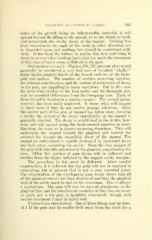Page 453 - My FlipBook
P. 453
EXCAVATIOX or CAVT'nK.S BV CLASSES. 203
nidus of the growth being on indestructible material, it will
spread beyond the filling to the mesial, or to the distal, or both,
and reestablish this chalky decay of the enamel. Nothing less
than extension to the angle of the tooth in either direction can
be depended upon, and nothing less should be considered suffi-
cient. It has been the failure to realize this fact and bring it
down to an everyday working l)asis that has made the treatment
of this class of cases seem so difficult in the past.
Description of case 2. Figures 286, 287, present what would
generally be considered a very bad case of so-called "chalky"
decay in the gingival thirds of the buccal surfaces of the bicus-
pids and molars. The number of cavities occurring together,
the extreme sensitiveness, and the visions of recurrence of decay
in the past, are appalling to many operators. But in this case
the individual cavities in the first molar and the bicuspids pre-
sent no essential differences from the foregoing case. Each of
them should be treated in a similar manner. The second molar,
however, has been badly neglected. It shows what will happen
in these cases if they do not receive prompt attention. After
the central part of the area of enamel has fallen away, forming
a cavity, the spread of the decay superficially on the enamel is
generally checked. The decay is established in the dentin, how-
ever, and will spread along the dento-enamel junction in evei'y
direction, the same as in decays occurring elsewhere. This will
undermine the enamel toward the gingival and toward the
occlusal far beyond the superfi_cial decay of the enamel. The
enamel so undermined is rapidly destroyed by backward decay
and falls away, enlarging the cavity. Soon the free margin of
the gum falls into this extension at tlie gingival, complicating the
case. Often this portion of gum tissue will be inflamed and
swollen from the injury inflicted by the ragged cavity margins.
The procedure in this must be ditt'erent. After careful
examination, it is believed that the pulp will not be exposed in
excavating, but at present that is not a very essential point.
The examination of the overlapping gum tissue shows that all
of the gingival enamel has been destroyed and that the gingival
wall of the cavity must be laid on the cementum. This is always
a misfortune. The gum will lose its normal attachment at the
gingival line, and the attachments rootwise of that line are never
so good, nor is the gum so healthful afterward; though with
careful treatment it may do fairly well.
Peeliminaky preparation. One of three things may be done.
(1.) If the gum may be readily held away from the tooth for a


